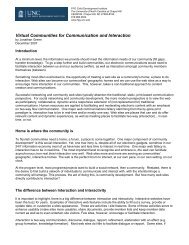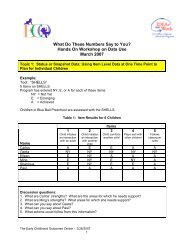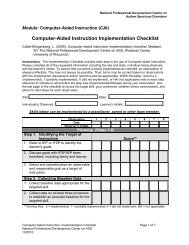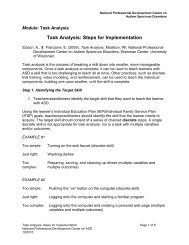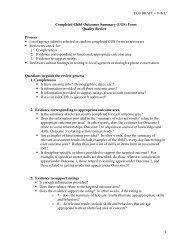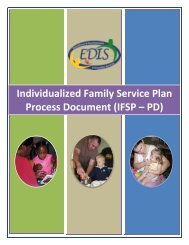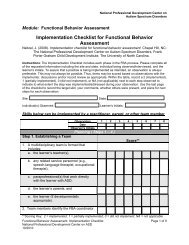Checklist for Video Modeling - National Professional Development ...
Checklist for Video Modeling - National Professional Development ...
Checklist for Video Modeling - National Professional Development ...
- No tags were found...
You also want an ePaper? Increase the reach of your titles
YUMPU automatically turns print PDFs into web optimized ePapers that Google loves.
<strong>National</strong> <strong>Professional</strong> <strong>Development</strong> Center onAutism Spectrum DisordersModule: <strong>Video</strong> <strong>Modeling</strong>Implementation <strong>Checklist</strong> <strong>for</strong> <strong>Video</strong> <strong>Modeling</strong>The implementation checklist steps were adapted from:LaCava, P. (2008). <strong>Video</strong> modeling: An online training module. (Kansas City: University ofKansas, Special Education Department). In Ohio Center <strong>for</strong> Autism and Low Incidence(OCALI), Autism Internet Modules, www.autisminternetmodules.org. Columbus, OH:OCALI.Instructions: The Implementation <strong>Checklist</strong> includes each step in the process of implementing videomodeling. Please complete all of the requested in<strong>for</strong>mation including the site and state, individual beingobserved, and the learner’s initials. To assure that a practice is being implemented as intended, anobservation is always preferable. This may not always be possible. Thus, items may be scored based onobservations with the implementer, discussions and/or record review as appropriate. Within the table,record a 2 (implemented), 1 (partially implemented), 0 (did not implement), or NA (not applicable) next toeach step observed to indicate to what extent the step was implemented/addressed during yourobservation. Use the last page of the checklist to record the target skill, your comments, whether otherswere present, and plans <strong>for</strong> next steps <strong>for</strong> each observation.Site: ________________________________________Individual (s) Observed: ________________________State: _______________________________Learner’s Initials: _____________________ _Skills below can be implemented by a practitioner, parent, or other team memberObservation 1 2 3 4 5 6 7 8DateObserver’s InitialsPlanning (Steps 1 – 6)Step 1. Targeting a Behavior <strong>for</strong>Teaching1. Identify a target behavior that is important tobe taught.2. Define and describe the target behavior sothat it is observable and measurable.Step 2. Having the Correct EquipmentScore**1. Acquire a video recording device (e.g., handheldvideo camera, digital camera, computertechnology).2. Identify how the video will be played back(e.g., DVD, VCR, computer).3. Become familiar with the equipment andcom<strong>for</strong>table using it.**Scoring Key: 2 = implemented; 1 = partially implemented; 0 = did not implement; NA = not applicable<strong>Video</strong> <strong>Modeling</strong>: Implementation <strong>Checklist</strong> Page 1 of 7<strong>National</strong> <strong>Professional</strong> <strong>Development</strong> Center on ASD10/2010
<strong>National</strong> <strong>Professional</strong> <strong>Development</strong> Center onAutism Spectrum DisordersModule: <strong>Video</strong> <strong>Modeling</strong>Step 3. Planning <strong>for</strong> the <strong>Video</strong> Recording1. Write a script or task analysis detailingexactly what needs to be said and/or doneon the video.Step 4. Collecting Baseline Data1. Learners complete as much of the skill aspossible.2. Collect baseline data to identify the steps ofthe task analysis that the learner cancomplete without assistance.Step 5. Making the <strong>Video</strong>1. Identify the kind of video that is appropriate<strong>for</strong> the learner (e.g., video modeling, selfmodeling,point-of-view modeling, videoprompting), based on the learner’s skill leveland preferences, as well as the targetbehavior.2. Prepare the model (with basic videomodeling) or the learner (with self-modeling)<strong>for</strong> the video.3. Record a video that is satisfactory in qualityand accurately reflects the steps of the taskanalysis.4. Edit the video and remove any errors andprompts.5. Complete voice-overs, if necessary.Observation 1 2 3 4 5 6 7 8DateObserver’s InitialsScore**Step 6. Arranging the Environment <strong>for</strong>Watching the <strong>Video</strong>1. Identify the environment where the video willbe watched, considering when and how it willbe used within natural routines.**Scoring Key: 2 = implemented; 1 = partially implemented; 0 = did not implement; NA = not applicable<strong>Video</strong> <strong>Modeling</strong>: Implementation <strong>Checklist</strong> Page 2 of 7<strong>National</strong> <strong>Professional</strong> <strong>Development</strong> Center on ASD10/2010
<strong>National</strong> <strong>Professional</strong> <strong>Development</strong> Center onAutism Spectrum DisordersModule: <strong>Video</strong> <strong>Modeling</strong>Observation 1 2 3 4 5 6 7 8Step 6. Arranging the Environment <strong>for</strong>Watching the <strong>Video</strong> (cont.)2. Ensure that the materials <strong>for</strong> theper<strong>for</strong>mance of the task match those on thevideo.Score**Step 7. Showing the <strong>Video</strong>1. Allow the learner to watch the video andprovide prompts necessary to gain and/orkeep attention.2. Allow the learner to watch the video anappropriate number of times be<strong>for</strong>eexpecting the learner to use the targetbehavior.3. For video prompting, stop the video aftereach step of the task analysis so the targetbehavior can be per<strong>for</strong>med by the learner.Intervention (Step 7)Progress Monitoring (Steps 8-10)Step 8. Monitoring Progress1. Collect data on the per<strong>for</strong>mance of the targetbehavior, noting the specific steps of the tasklearners were able to do independently.2. Note how often and when the learnerwatches the video when using the targetbehavior.3. If after collecting data on three to fiveoccasions, learners are not making progress,begin troubleshooting (see Step 9). Iflearners are making progress, instruction iscontinued until they have reached maximumproficiency.**Scoring Key: 2 = implemented; 1 = partially implemented; 0 = did not implement; NA = not applicable<strong>Video</strong> <strong>Modeling</strong>: Implementation <strong>Checklist</strong> Page 3 of 7<strong>National</strong> <strong>Professional</strong> <strong>Development</strong> Center on ASD10/2010
<strong>National</strong> <strong>Professional</strong> <strong>Development</strong> Center onAutism Spectrum DisordersModule: <strong>Video</strong> <strong>Modeling</strong>Step 9. Troubleshooting if the Learneris Not Making Progress1. Analyze the learner’s progress by monitoringdata to identify changes needed <strong>for</strong> the videomodeling procedures.2. Adjust intervention tactics to help the learnermake progress by asking:Observation 1 2 3 4 5 6 7 8DateObserver’s InitialsScore**a. Is the learner watching the video enoughtimes per week?b. Is the learner watching the video, but notattending to the most relevant parts?c. Is the learner getting enough promptingfrom adults and/or peers to use thetarget behavior?d. Is the learner receiving the appropriateamount and type of rein<strong>for</strong>cement <strong>for</strong>per<strong>for</strong>ming, or attempting to per<strong>for</strong>m, thetarget behavior(s)?e. Is the video too complex? andf. Does another task analysis need to becompleted to make sure that the videoincludes the correct steps?3. Implement the adjustments to the videomodeling procedures.**Scoring Key: 2 = implemented; 1 = partially implemented; 0 = did not implement; NA = not applicable<strong>Video</strong> <strong>Modeling</strong>: Implementation <strong>Checklist</strong> Page 4 of 7<strong>National</strong> <strong>Professional</strong> <strong>Development</strong> Center on ASD10/2010
<strong>National</strong> <strong>Professional</strong> <strong>Development</strong> Center onAutism Spectrum DisordersModule: <strong>Video</strong> <strong>Modeling</strong>Step 10. Fading the Prompting and the<strong>Video</strong>1. Teachers/practitioners fade the use ofprompting to encourage independent useand to promote maintenance of the targetbehavior.2. Teachers/practitioners use one or more ofthe following procedures when fading videos:a. delaying start/premature stop,b. error correction, andc. scene fading.3. Teachers/practitioners allow the learner tocontinue watching the video to some extent ifit is appropriate, enjoyable <strong>for</strong> the learner,and supports the behavior.Observation 1 2 3 4 5 6 7 8DateObserver’s InitialsScore****Scoring Key: 2 = implemented; 1 = partially implemented; 0 = did not implement; NA = not applicableReferenceSigafoos, J., O’Reilly, M., & de la Cruz, B. (2007). How to use video modeling and videoprompting. Austin, TX: Pro-Ed.<strong>Video</strong> <strong>Modeling</strong>: Implementation <strong>Checklist</strong> Page 5 of 7<strong>National</strong> <strong>Professional</strong> <strong>Development</strong> Center on ASD10/2010
<strong>National</strong> <strong>Professional</strong> <strong>Development</strong> Center onAutism Spectrum DisordersModule: <strong>Video</strong> <strong>Modeling</strong>DateObserverInitialsTarget Skill/Behavior, Comments, and Plans <strong>for</strong> Next StepsDateObserverInitialsTarget Skill/Behavior, Comments, and Plans <strong>for</strong> Next StepsDateObserverInitialsTarget Skill/Behavior, Comments, and Plans <strong>for</strong> Next StepsDateObserverInitialsTarget Skill/Behavior, Comments, and Plans <strong>for</strong> Next Steps<strong>Video</strong> <strong>Modeling</strong>: Implementation <strong>Checklist</strong> Page 6 of 7<strong>National</strong> <strong>Professional</strong> <strong>Development</strong> Center on ASD10/2010
<strong>National</strong> <strong>Professional</strong> <strong>Development</strong> Center onAutism Spectrum DisordersModule: <strong>Video</strong> <strong>Modeling</strong>DateObserverInitialsTarget Skill/Behavior, Comments, and Plans <strong>for</strong> Next StepsDateObserverInitialsTarget Skill/Behavior, Comments, and Plans <strong>for</strong> Next StepsDateObserverInitialsTarget Skill/Behavior, Comments, and Plans <strong>for</strong> Next StepsDateObserverInitialsTarget Skill/Behavior, Comments, and Plans <strong>for</strong> Next Steps<strong>Video</strong> <strong>Modeling</strong>: Implementation <strong>Checklist</strong> Page 7 of 7<strong>National</strong> <strong>Professional</strong> <strong>Development</strong> Center on ASD10/2010




